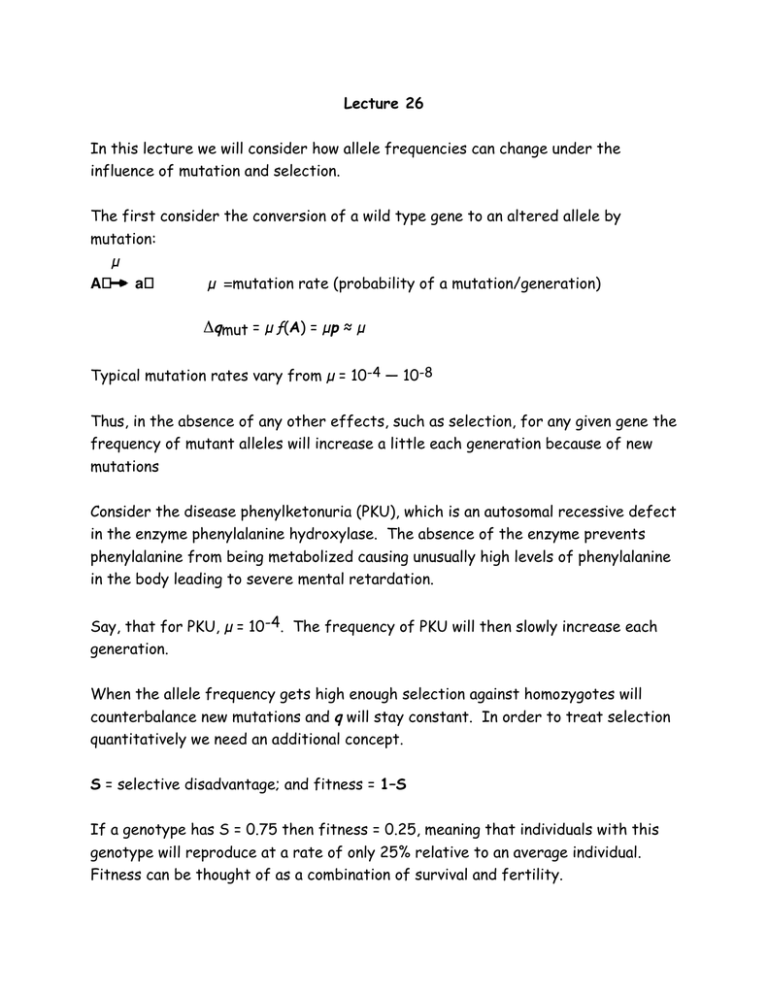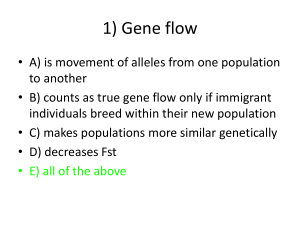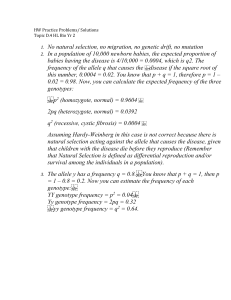Lecture 26 influence of mutation and selection.
advertisement

Lecture 26 In this lecture we will consider how allele frequencies can change under the influence of mutation and selection. The first consider the conversion of a wild type gene to an altered allele by mutation: µ A → a µ =mutation rate (probability of a mutation/generation) Δqmut = µ ƒ(A) = µp ≈ µ Typical mutation rates vary from µ = 10-4 — 10-8 Thus, in the absence of any other effects, such as selection, for any given gene the frequency of mutant alleles will increase a little each generation because of new mutations Consider the disease phenylketonuria (PKU), which is an autosomal recessive defect in the enzyme phenylalanine hydroxylase. The absence of the enzyme prevents phenylalanine from being metabolized causing unusually high levels of phenylalanine in the body leading to severe mental retardation. Say, that for PKU, µ = 10-4. The frequency of PKU will then slowly increase each generation. When the allele frequency gets high enough selection against homozygotes will counterbalance new mutations and q will stay constant. In order to treat selection quantitatively we need an additional concept. S = selective disadvantage; and fitness = 1–S If a genotype has S = 0.75 then fitness = 0.25, meaning that individuals with this genotype will reproduce at a rate of only 25% relative to an average individual. Fitness can be thought of as a combination of survival and fertility. Recall that for alleles in H-W equilibrium (random mating) the genotype frequencies will be: ƒ(A/A) = p2, ƒ(A/a) = 2pq, ƒ(a/a) = q2 Genotype frequency p2 2pq A/A A/a q2 a/a after selection Δ frequency p2 2pq q2 (1 – S) 0 0 –Sq2 #qsel = –Sq2 In the steady state: #qsel + #qmut = 0, –Sq2 + µ = 0, µ = Sq2 q = . µ/S For PKU, q is 10-2 Sand during human evolution S ≈ 1. Therefore, the estimated value of µ is about 10-4. The actual mutation frequency is probably not this high – and the relatively high q for PKU is probably due to a founder effect in the European population or a balanced polymorphism (see below). In modern times PKU can be treated by a low-phenylalanine diet so S < 1. So the frequency of PKU should start to rise at a rate #qmut = 10-4. Thus, q will only increase by a factor of 1% per generation and it will take a long time for this change in environment to have a significant effect on disease frequency. Now let’s determine the steady state allele frequency for a dominant disease with allele frequency q = ƒ(A). In contrast to the situation for recessive alleles, for dominant alleles selection will operate against heterozygotes. Note that for a rare dominant trait almost all affected individuals are heterozygotes. q = ƒ(A/A) + 1/2 ƒ(A/a) ≈ 1/2 ƒ(A/a) Genotype frequency – 2pq ≈ 2q A/A A/a p2 a/a Δ frequency after selection – (1 – S) 2q – –2Sq p2 0 Δqsel = 1/2 [Δ ƒ(A/A)] = 1/2 (–2Sq) = -Sq (After selection, 2Sq heterozygotes are lost each generation but only 1/2 of their alleles are A. So the net reduction in ƒ(A) is –Sq.) In the steady state: Δqsel + Δqmut = 0, q = µ/S –Sq + µ = 0, µ = Sq For S = 1, q = µ In other words, for dominant mutations with fitness = 0, the only instances of the disease will be due to new mutations. This makes sense because mutant alleles cannot be passed from one generation to the next. In this case, the number of affected individuals will be 2µ. When S<1 the frequency can get quite high. A good example of this is Huntington's disease which has a late onset of degeneration of neuromuscular system at > 35 yrs. This disease is bad personally but doesn't decrease reproductive fitness much. For the final example of a balance between mutation and selection, consider an Xlinked recessive allele with frequency q = ƒ(a). For rare alleles the vast majority of affected individuals who are operated on by selection are males, and new mutations will increase the allele frequency Δqmut ≈ µ Genotype XA Y Xa Y frequency after selection p p q (1 – S)q ! frequency 0 –Sq Note that in a population of equal numbers of males and females, 1/3 of the X chromosomes will be in males. Therefore, Δqsel = 1/ 3 [Δ ƒ(Xa Y)] = 1/3 (–Sq) = -Sq/3 In the steady state: Δqsel + Δqmut = 0, -Sq/3 + µ = 0, µ = Sq/3 q = 3µ/S For S = 1, q = 3µ For X-linked recessive mutations with fitness = 0, exactly one third of the alleles in a population will be new mutations. This relationship has been demonstrated for the debilitating X-linked diseases hemophilia A and Duchenne muscular dystrophy. Balanced Polymorphism Now we will consider a situation in which an allele is deleterious in the homozygous state but is beneficial in the heterozygous state. The steady state value of µ will be set by a balance between selection for the heterozygote and selection against the homozygote. We will need a new parameter that represents the increased reproductive fitness of heterozygote over an average individual. h = heterozygote advantage Genotype frequency A/A p2 2pq ≈ 2q A/a a/a q2 after selection p2 (1 + h) 2q (1 – S)q2 ! frequency 0 – Sq2 Δq = Δ ƒ(a/a) + 1/2 Δ ƒ(A/a) = – Sq2 + 1/2(2hq) = – Sq2 + hq Say S = 1, then Δq = 0 when q2 = hq i.e. h = q 2hq The possibility of a subtle selection for (or against) the heterozygote for an allele that appears to be recessive means that in practice the estimates of µ from allele frequencies are quite unreliable. For example, q = 10-2. This could mean µ = 10-4 and h = 0 or µ < 10-4 and h = 10-2. Since a 1% increase in heterozygote advantage would be essentially unmeasurable we couldn't distinguish these possibilities. The best understood case of balanced polymorphism is sickle-cell anemia The allele of hemoglobin known as HbS is recessive for the disease but is dominant for malarial resistance. HbS is most prevalent in a number of different equatorial populations where malaria is common: sub-Saharan Africa, the Mediterranean, and Southeast Asia. In parts of Africa the frequency of the disease can be as high as ~ 2.6 %, which means that in these populations q = 0.16. During human history sickle cell disease would almost certainly be fatal thus S ≈ 1 and therefore h must have been about 0.16. This indicates that during evolution the reproductive advantage for an HbS heterozygote is 16%. Many of the most prevalent genetic diseases are suspected to be at a relatively high frequency because of balanced polymorphism. Cystic Fibrosis: Autosomal recessive mutations in CFTR (Cystic fibrosis transmembrane conductance regulator). Mutants disrupt Cl– transport leading to disturbed osmotic balance across in epithelial cell layers of the lungs and intestine. Incidence in European populations ≈ 1/2000. Thus, q = 0.05 This high frequency is probably not due to either high mutation frequency or founder effect (many different alleles have been found although 70% are #F508). The hypothesis is that heterozygotes may be more resistant to bacterial infections that cause diarrhea such as typhoid or cholera and that this selection was imposed in densely populated European cities. A second example is a set of different autosomal recessive lysosomal storage disorders Allele frequency Disease Enzyme (maximum) Gaucher glucocerebrosidase 0.03 Tay-Sachs hexosaminidase A 0.017 Nieman-Pick sphyngomylinase 0.01 All three enzymes are involved in breakdown of glycolipids in the lysosome. When these enzymes are defective (in individuals heterozygous for the disease allele) excessive quantities of glycolipids build up in cells and can have pathological effects. In particular all three diseases are characterized by mental retardation because of excess glycolipids in neurons. All three diseases are ~ 100x more common in Ashkenazi Jewish populations. This group arrived in central Europe in 9th century AD and is currently distributed among US, Israel, and the former Soviet Union. The competing theories to explain the unusually high allele frequencies are balanced polymorphism or founder effect.







